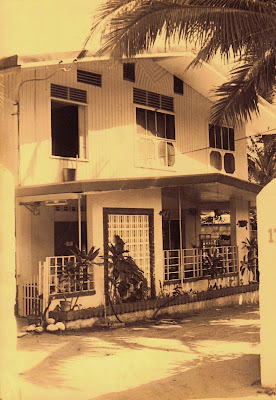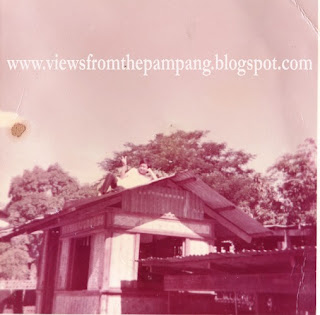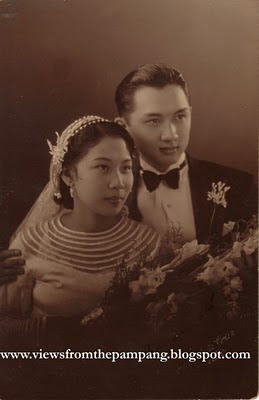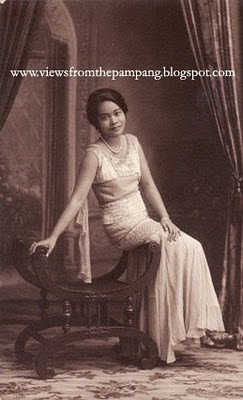 AND THE HOUSE CAME FALLING DOWN. From a two-storey house, our old residence was made smaller for practical reasons: in 2000 we have all flown the coop and by then the house was in total disarray, rented out to various people we hardly knew. It was still sad to see the upper floor go.
AND THE HOUSE CAME FALLING DOWN. From a two-storey house, our old residence was made smaller for practical reasons: in 2000 we have all flown the coop and by then the house was in total disarray, rented out to various people we hardly knew. It was still sad to see the upper floor go. Our street, which stretches for just about 250 meters, was actually just a side street and for the longest time, remained unpaved. I hated walking down the dirt road, especially after the rains; a slight downpour would turn the road sticky and muddy. The worse was stepping on moist carabao dung, and many a rubber sandal were lost in the warm smelly trap left behind by these lumbering damulags. The town abattoir faced our street, permeating the air not just with the stench of scalding flesh but also the piercing wails of death-resistant pigs.
The commandment “Love thy Neighbor” was followed to the letter in our street, as our relationships with everyone was cloyingly sweet. Everyone it seemed, looked out for each other. Imang Saning ran the street’s only sari-sari store; her daughter Luz was my classmate. There, we could make “pa-lista” if our budgets were tight but 1 or 5 centavos is enough to buy Texas bubble gum, Senorita Lemon or toothsome belekoy. My favorites were the pink, coconut laced cookies in glass garapons. For the same price, you can take a chance on the “bagutan” , where anything—from a toy balloon or a plastic gun-- can be yours for the picking. On the other hand, my sister loved renting komiks there, and I myself would avidly follow the serialized stories of “Sindak” or “Ngitngit ng Pitong Whistle Bomb” on Tagalog Klasiks.
Tatang Felix Castro and Mang Saning worked for my lolo in managing his agricultural lands for some time. They would either housesit or babysit us whenever my parents or lolo went on overnight trips to Manila. My father became a good buddy of their son-in-law Master Sgt., Arthur Dandridge, who married their daughter, Atching Ester.
I always admired the little house of the Tungol family with its rows of green bushes and flowers. I longed to have a house that organized. Kong Inggo was our resident on-the-go-barber. He would come to our house at a moment’s notice as his house was just a stone’s throw from ours. Many years later, I would be reacquainted with his daughter, Jet, in Bangkok, Thailand, of all places, where he and her American husband were stationed. Within the vicinity was also Atching Zenai’s big compound. She would sometimes send food over and my mother would return the kind gesture with another dish. That’s how it was in those days.
Also close to us are the family of Ingkung Raling and Apung Gayang Morales. Bapang Roxann was my classmate from elementary to high school. Atty. Morales was a respected lawyer who would always handle all our family’s legal cases.
Our other Morales relatives often had caretakers to tend to their large, imposing house. When they were not around, we would go over the fence and play hide and seek or tambubung on the spacious, paved grounds. Whenever we felt more adventurous, we would ascend the azotea stairs or climb up all the way to the second floor, trying to see what lies within. I remember peering through the persiana slats to see an ancient portrait of an old woman with soulful eyes that follow your every move. I was scared stiff! Little did I know that she was my paternal great grandmother, Apung Palu.
To the left of us are the Madlangbayans and directly in front of us, the compound of Tatang Senti de la Cruz. Their children were our playmates and when we were not engaging them with several rounds of siyatung (game played with sticks), we were conducting war games. Tatang Senti had a number of carabaos and we would worry him no end by scaring his herd with firecrackers. Today, his son Sekwat and I are magka-“kumpares”.
The Concepcions, first cousins of my Dad, also were on the same street. I also remember the Macaspac family in that area, as Remedios was my grade school classmate. Sadly, she passed away at a tender age.
The farther I went down the road, the less and less people I knew.
Where our rural street converged with the other, more populated Sta. Ines street, that’s where my little journey ended.
*****
I left our house in Sta. Ines in 1984.By then it had acquired a new number (No. 179) and the street had been given a new name (Sampaguita St.). In the 1998, the street name was again changed to Vicente de la Cruz St., in honor of Tatang Senti, our front-door neighbor. By then too, my father had passed away and my mother moved out of Sta. Ines to join me in my matchbox-size, SSS-financed house in Casmor. Our big house, now empty and termite-ridden, had become but a store room for our old furniture, aparadors and odds and ends of accumulated junk.
In January of 2001, I decided to have the house remodeled and made smaller for practical reasons. When the whole upper storey where my room used to be was finally demolished, a piece of my past also came crashing down.














